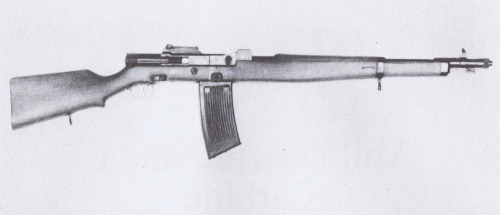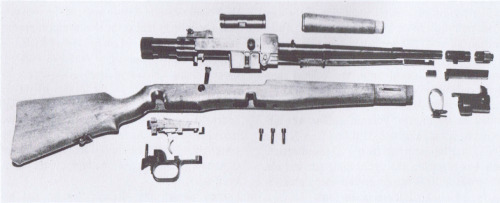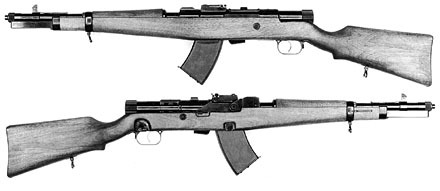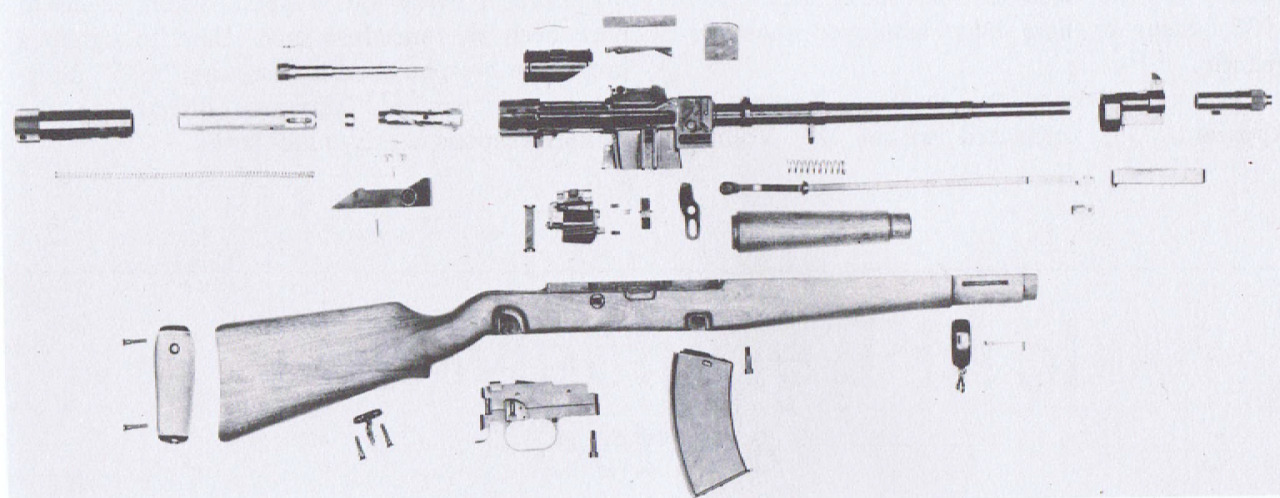VOLLMER M35
While Germany’s wartime experiments with self-loading and automatic rifles are well known, one of the most impressive earlier attempts was made by Heinrich Vollmer. Vollmer is best known for his work with submachine guns such as the Erma EMP-35 and with elements of his work being used in the MP38/MP40.
In the early 1930s Vollmer had been working on submachine gun designs, a light machine gun and a semi-automatic rifle, the Selbstladegewehr 29, chambered in 7.92x57mm. This design was rejected however, in early 1935 he was asked to develop a similar rifle capable of firing a new cartridge developed by GECO. GECO (Gustav Genschow & Co) had developed a new 7.7x40mm intermediate round at the request of the Heereswaffenamt (Germany’s military weapons development establishment). Ballistically the GECO round was larger than the later 7.92mm Kurz round with a heavier 140 gr projectile and a faster velocity of approximately 2,280 ft/s.
Vollmer developed a select fire rifle called the Vollmer-Maschinenkarabiner 35 or M35 to fire GECO’s new round. Like the later G41 rifles Vollmer’s carbine used a gas trap at the muzzle with a system similar to that developed by Soren Bang. The Heereswaffenamt disliked self-loading rifle designs which tapped gas directly from the barrel, this was a prejudice which would last well into the war. The rifle had a rotating bolt with the action linked to the trap by a piston (seen beneath the barrel). The M35 fed from a curved 20-round box magazine.

Vollmer Selbstladgewehr (SG 29), note the different selector switch, lack of elongated bolt handle and longer barrel (source)
Testing on the first model began in July in 1935, and found that when in the fully automatic mode the rifle could fire at a rate of up to 1,000 rounds per minute. Further testing was carried out with a second prototype, the M35A. Some feed and ejection problems were identified in this model and more refinement was carried out. This led to the M35/II which rectified the ejection problems. The Heereswaffenamt requested further changes to lower the rate of fire and allow mass production, however, simplification of Vollmer’s complex design was possible. Vollmer, however, did develop a pneumatic buffer which slowed the rate of fire down to a more reliable ~400 rounds per minute. A further refinement, the, was developed after problems with feeding and ejection were discovered and further testing took place throughout 1936 and 1937 with ~13,000 rounds fired with no major issues or stoppages suffered.
With the rate of fire reduced the Heereswaffenamt agreed to continued testing with the hope for future adoption. The M35/III (see images 1 & #2) also saw small changes in barrel length, selector switch configuration and a slightly larger bolt handle which could be cycled manually if the gas system failed. The latter was a requirement which remained in place with the G41 rifles also required to have an action which could be cycled manually. It had an overall length of 38 inches, 5 inches shorter than the K98k, and a weight of approximately 9.25 lbs.

A Disassembled Vollmer A35II (Source: German Assault Rifle 1935-45 - P. Senich)
Official testing and evaluation of the M35/III took place on 21st September 1938. The weapon was well received and the Heereswaffenamt requested 25 carbines for further trials. These were handmade by Vollmer’s firm and the M35/IIIs were found to be extremely reliable. Both the German army and the Luftwaffe were interested in the rifle with demonstrations continuing into early 1939. However, the project was cancelled and the rifle rejected in the summer of 1939. In August 1939, Germany invaded Poland beginning World War to, with war imminent in the summer of 1939 it was believed that despite its promise the Vollmer carbine would be too complex and too expensive to manufacture in large enough numbers, especially during wartime.
The intermediate round and lightweight select-fire rifle concept survived with the Heereswaffenamt issuing specifications for a new light, intermediate rifle with a simple action in 1939. This would result in competing designs from Walther and Haenel chambered in Polte ammunition works’ new 7.92×33mm kurz round and would culminate with the StG-44.
The M35 was Vollmer’s last small arms project, at the beginning of World War Two he stepped back from his design role. His company continued to make parts for the MP40 and other industrial machinery, Vollmer died in 1961 aged 76. The Vollmer M35 represents one of Germany’s best early forays into automatic (and assault rifle) design.


